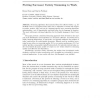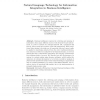468 search results - page 89 / 94 » Application of Fuzzy Rule Induction to Data Mining |
GFKL
2006
Springer
13 years 11 months ago
2006
Springer
Stemming algorithms find canonical forms for inflected words, e. g. for declined nouns or conjugated verbs. Since such a unification of words with respect to gender, number, time, ...
BIS
2007
13 years 9 months ago
2007
Business intelligence requires the collecting and merging of information from many different sources, both structured and unstructured, in order to analyse for example financial ...
DMIN
2009
13 years 5 months ago
2009
- Over the last twenty years, text classification has become one of the key techniques for organizing electronic information such as text and web documents. The k-Nearest Neighbor ...
ICDE
2004
IEEE
14 years 9 months ago
2004
IEEE
Several spatio-temporal applications require the retrieval of summarized information about moving objects that lie in a query region during a query interval (e.g., the number of m...
KDD
2005
ACM
14 years 8 months ago
2005
ACM
Dyadic data matrices, such as co-occurrence matrix, rating matrix, and proximity matrix, arise frequently in various important applications. A fundamental problem in dyadic data a...


